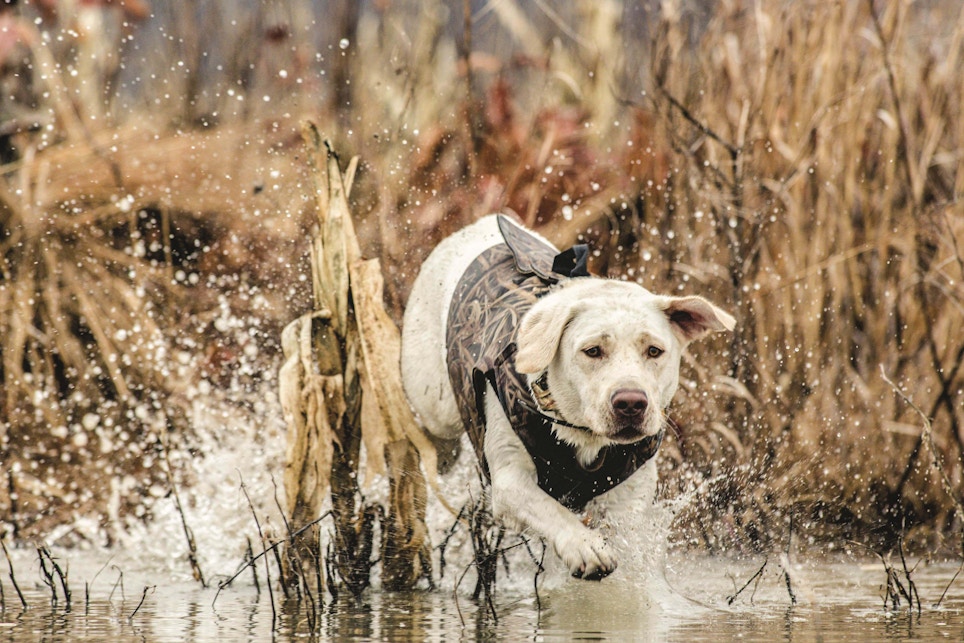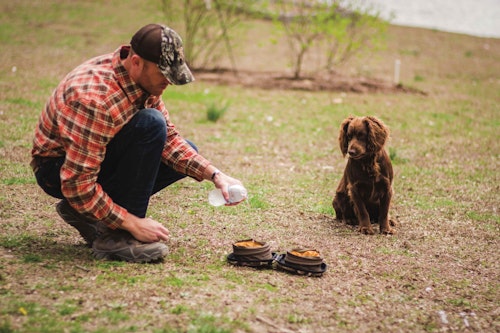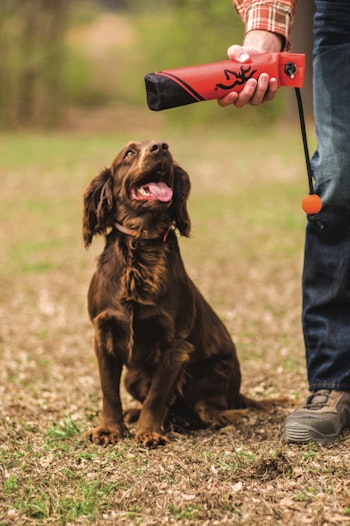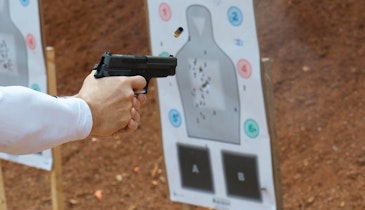Along with being wonderful family companions, dogs of many breeds are used for hunting a wide variety of different game species. Pointing dogs hunt everything from quail to pheasant to various grouse species, while retrieving dogs are often used for hunting those same species plus waterfowl. Flushing breeds are used to hunt upland birds also, and a wide variety of hunting hounds pursue everything from rabbits to mountain lions.
In addition to hunting, many owners of all these different types of hunting dogs participate in field tests, field trials, hunt tests and various other organized dog-focused sports. Not surprisingly, these dog fanciers spend a lot of money pursuing their activities. Your establishment might as well be reaping some of that profitable reward.
It’s likely that retailers who aren’t very familiar with hunting with dogs might consider this to be a very small niche, but that’s far from the truth. Let’s take a look at some product categories you can carry in your establishment to start making money from hunting dog owners.
Basics
Collars are about as basic as hunting dog equipment gets. But the fact is, most dog owners prefer their dogs to have a collar, so the sales potential is high.
While many hunters prefer strong leather collars, others like nylon collars because they can be made in bright colors and will last nearly forever. Regardless, a collar with a nameplate is always better for hunting dog owners than one without, just in case they lose the dog and someone finds it.
Leashes are a must-have for dog owners, as they are necessary for taking dogs on walks or controlling dogs anytime they are out in public. From nylon to leather, there are lots of different kinds, and what dog owners like is mainly a matter of personal preference.
While many hunting dogs live outdoors in kennels, a growing number of hunting dog owners keep their dogs inside as home companions and hunting companions. Consequently, the market for dog beds for either lounging around in the living room or for putting in their crate if they are crate trained is a robust one. From simple carpets to extravagant gel-foam models, dog beds are also a matter of the dog owner’s personal choice.
Food and water bowls are also basic necessities that hunting dog owners have to buy somewhere. Most hunting dog owners don’t feed their dogs with self-feeders that allow dogs to eat as much as they want since keeping them in top physical condition is a priority. Stainless bowls are popular because they last a long time and are hard to destroy, even for dogs that like to chew things. Hard plastic bowls are another good option that many hunting dog owners prefer.
Training Accessories
Next, let’s look at training necessities. Most hunting dog owners, especially for pointing dogs, are going to need a good check cord among their training equipment. A check cord is just a fairly stiff braided rope, usually about 15 to 25 feet long, with a metal snap on one end. It is used to control the dog when teaching it a number of commands, as well as to restrain dogs from chasing when working on steadiness to wing or steadiness to wing and shot.
Since check cords take a lot of abuse, you’ll want to stock very strong, durable cords that won’t begin to fray with a little mistreatment. Many times these long leads are dragged by dogs very fast through rough brush, so they will take a beating.
For many dog owners and trainers, e-collars are among the most popular training tools these days. They’re also among the most expensive, but many hunters and field trainers are willing to pay a high price to ensure they have the proper tools for training their dogs to be the best they can be.
While there are some who believe the use of e-collars for training is cruel, that couldn’t be further from the truth. Most who say that have never used one or don’t know how to use one properly and humanely. Top manufacturers of e-collars include Garmin, SportDOG and Dogtra. Carrying a few models in the lower-end price range, a few in the middle and one or two top-tier collars is probably a good sales strategy, as it will give dog owners on all budgets an opportunity to make a purchase.
Tracking collars are also very popular. These employ GPS technology and allow a dog owner to always know exactly where his or her dog is located at any given time. These make the likelihood of losing a dog much lower, which is an important factor with the high price of a purebred hunting dog. Some companies make combination collars that can be used for training and tracking, giving hunters and trainers the best of both worlds in one collar system.
For dogs that bark a lot, as many hunting dogs tend to do, a bark collars can sometimes mean the difference between peace in the neighborhood and all-out war. Bark collars administer a mild electric shock to a dog when it barks. While it might be a little painful, dogs quickly learn that not barking solves the problem — at least when they’re wearing the collar.
Launchers are another important training tool. For pointing and flushing dogs, we’re talking mainly about bird launchers, which are designed to hold a pigeon, quail or chukar securely and safe from your dog until you are ready to release it. Most launchers are electronic and have a remote control that allows the user to launch the bird when he or she is ready. Compared to using loose live birds, launchers give the trainer a great deal more control over the situation — always a good thing.
Retrieving dog owners and trainers are more likely to need a dummy launcher, although many also utilize bird launchers when training retrievers to hunt upland game. Dummy launchers range from handheld units to extravagant contraptions that can throw retrieving dummies a very long distance, so models are available in a wide range of prices.
Retrieving dummies are also good sellers for both upland bird hunters and waterfowl hunters, as retrieving all downed game is crucial to ethical hunting. Most retrieving dummies are plastic with a rope attached to one end and can be thrown a great distance when training dogs to retrieve upland birds or waterfowl. Some are hard plastic and shaped like ducks for use in training water retrieving breeds.
Since most hunting involves shooting guns, it is important that dogs are trained from an early age to not be “gun shy,” a term to describe oversensitivity to loud noises. This training is usually accomplished through the use of a blank gun. Blank guns are also frequently used during typical training scenarios, and are also employed during field trials in which birds are not actually shot.
While cheap blank guns are available, most hunters and trainers have seen how short a time it takes before they fall apart. In fact, “Buy once, cry once,” is a common mantra among dog trainers concerning blank guns, so carrying a top-of-the-line blank pistol or two in your inventory might pay off. Be sure to carry blanks for all the different calibers of guns you choose to have in your inventory. These typically include .22 and .32 blanks, as well as 209 shotgun primers.
Lastly, since most dog owners are constantly seeking new knowledge about how to better train their dogs, various training books, videos and DVDs are available to help instill that knowledge. Keeping a few on hand could result in an additional sale or two to hunters shopping for training equipment.
Hunting Gear
Believe it or not, dog vests are quite popular and represent a potential profit center for retailers hoping to cater to hunting dog owners. For retriever breeds, most vests are neoprene and are helpful in keeping dogs warm when swimming in frigid waters. These come in many camouflage patterns to blend in while hunting in duck blinds.
Many upland bird hunters also use vests for their dogs, but these are a completely different type of vest. Vests made for upland hunting dogs are typically designed to protect a dog’s chest and other important body parts when hunting in very thick brush, especially in areas where vegetation tends to poke, gouge or cut a hard-running canine.
Also, don’t overlook dog boots. While that might sound like a luxury, a good set of boots is an absolute necessity for gun dogs in areas with lots of sand burrs, cactus, sharp rocks and other things that cause foot problems. A hunting dog that can’t run won’t find many birds, so keeping their feet in shape is a critical component of hunting dog care.
Dog boots are made by a variety of manufacturers from different materials, ranging from rubber to nylon and other types of fabric. The best ones come in a variety of sizes and are easy to put on and take off. Many owners of non-hunting dogs in warmer areas of the country also utilize these same types of dog boots when walking their dogs on hot pavement or allowing them to run in areas with lots of sand burrs or rocks, so carrying a variety of sizes is a good idea.
Another popular item among many gun dog owners is a good gun dog first aid kit. Different types of hunting present different dangers, including cuts, scrapes, broken bones, hypothermia (low body temperature), hyperthermia (overheating), ripped pads, foreign bodies in their eyes and a variety of other emergencies.
A few different companies make gun dog first aid kits, and they range from very simple to quite extravagant. It doesn’t hurt to keep a few top-of-the-line kits in stock, as this is another accessory that many hunters refuse to cut corners on.
Wrap-up
As you can see, there’s a wide world of hunting dog-related products out there, and many potential new customers you likely haven’t reached yet. A good starting point is to find out what kinds of hunting, trialing and field tests are popular in your area, then determine what equipment is most often used by participants in those activities. That’ll give you a head start on determining the best products to carry in your inventory.








